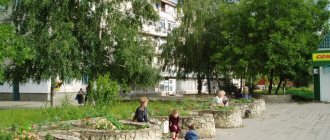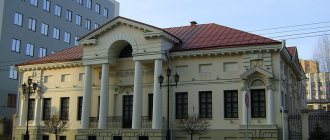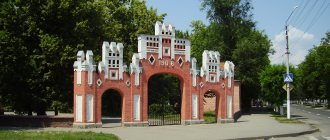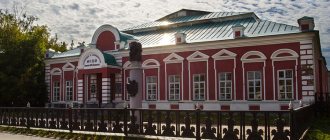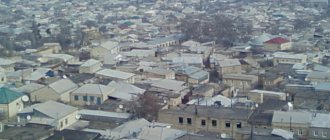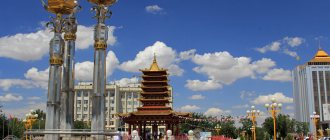City of Kologriv
View of Kologriv from across the Unzha River.
1875 Photo by Perepelkin A. The history of Kologriv consists of two stages. The first is the story of Old Kologriv, which stood thirty-three kilometers higher along the Unzha River. In the 16th century there was a Shishkilevskaya volost here, the center of which was considered to be the churchyard with the Church of St. Michael the Archangel. The Shishkilevo volost was densely populated, the villages mainly occupied the right bank of the Unzha, cut across by ravines with forest manes on the hills. The Shishkilevo volost has been mentioned in chronicles since 1536, when it was attacked by the Kazan Tatars, who were raiding the Galich region.
Shishkilevo was also mentioned in 1563, when, by order of Ivan the Terrible, warriors were collected for the Livonian War. But neither in 1536 nor in 1563 was Shishkilevo called Kologriv. Apparently, Kologriv was founded as a fortress on the high bank of the Unzha near the Arkhangelsky (Shishkilevsky) churchyard
In the boundary book of the Galich district in 1647 it is written: “Between the Kologriv posad land there is the same Kologriv town Pushkar land from the city behind the ravine there is a cemetery and there used to be a church of the Archangel Michael and that church was moved to the mountain side, and now on the church site there is a chapel and behind the chapel there is a courtyard - the hedge of priest Mikita and his children, and priest Denisey serves in the settlement near the district church of Macarius the Wonderworker, and another son Boris serves in the city with the Archangel Michael.” This entry sheds light on the history of Old Kologriv. When a wooden fortress was built on the right bank of the Unzha, it was called Okologrivye, that is, located at a high ridge, between the ravines. Later, the letter “O” was dropped and the fortress was called Kologriv. The Church of St. Michael the Archangel, which stood nearby in the churchyard, was moved to the city in compliance with all traditions: when the church was moved to a new location, the name was preserved, and a chapel was erected in the old place. The place was sacred and was not subject to development. Near the fortress, the Makaryevskaya Church was built for the parishioners of the volost.
Resurrection (Makaryevskaya) Church. Lithography. Kologriv Local History Museum named after. G.A. Ladyzhensky.
In 1700, the line of the Kasimov kings died out, and the villages of the Kichinsky volost were transferred to the Palace Prikaz, they began to be distributed to the estates of serving people as salaries for their service.
When the Kologriv fortress lost its military significance in the middle of the 16th century. (after the fall of the Kazan Khanate), they no longer followed her. “The city of Kologriv on the river on the Unzha tree is dilapidated and there is not a single gorodnaya before the river to Unzha, and in the city there is a cathedral church of Michael the Archangel and in Kologriv on the settlement there is a church of the ancient Macarius the Wonderworker,” - recorded in the patrol book of 1616. The walls consisted of gorodny - longitudinal wooden log houses, placed in a row and covered with earth inside for stability.
In the census book of 1627-1628. we read: “A Galician suburb in Kologriv, Pushkar children in the yard of Pyatunka and Ivashka Mikitin, Sobakin’s children, and the messenger Senka Grigoriev, son of Sukhonogov, and in Kologriv, the Arkhangelsk priest Nikita owns the Pushkar land.”
Over time, Old Kologriv became more and more frail. In 1648 it was written: “In the town of Okologrivye and in the suburb there are no tax-paying people or laborers.” And only the churches still stood here at that time. When the administration completely abandoned this place and moved to the Kichino churchyard, Old Kologriv began to be called, after its main church, the village of Arkhangelsk, and it became the center of the Arkhangelsk volost. The name Shishkilevo was forgotten and was not mentioned in the documents.
Kologriv shopping area at the beginning of the twentieth century.
A new place for Kologriv was chosen and approved by the Yaroslavl-Kostroma governor A.P. Melgunov; The official founding date is considered to be 1778. But long before that, all Kologriv institutions were transferred to Kichino.
Here is what Major Panfilov, sent from the Galich provincial chancellery, wrote in 1767: “The Kologriv chancellery in the Kichino churchyard was built by the first governor Ivan Rogozin in 1728, houses were built there for residence, but in the Galich chancellery there is no mention of all this. Yes, in the Kichino churchyard there was built a building for the state kost, a drinking house for the sale of wine, a cellar where supply wine is stored, and a barn for the sale of salt, but the governor built everything in Kichino by arbitrariness.”
Panfilov recognizes the advantages of Kichino: “And in the village of Kichino, where the voivode’s office is now located, a prison hut, a drinking house, a salt barn, a state-owned winery, two wooden churches, three priests’ courtyards, four philistine houses, a regular team of soldiers of sixteen people, and villages there are different ones close to this village. The position of this village and the place opposite the city of Kologriv is good and better. Water is taken nearby from the Unzha and Kichinki rivers. It is better to get any kind of forest construction nearby, and besides, a large road has been cleared to the same village of Kichin, I find it convenient to have everything in the village of Kichin, rather than transporting the entire structure to Kologriv, and transporting everything will be a loss to the treasury.”
So, the city owes the transfer of Old Kologriv to the village of Kichino not to the governor A.P. Melgunov, but to the governor Ivan Ivanovich Rogozin. This is the son of clerk Ivan Rogozin, who served at the end of the 17th century in the order of the Galich Chet in Moscow. He was granted an estate by Tsar Alexei Mikhailovich during the Chukhloma siege. The memory of governor I.I. Rogozin as the founder of modern Kologriv in 1728 must be preserved.
According to the census of 1616, Kichino was in the Ileshevsky volost. It is written in it: “The churchyard in Kichin on the Unzha River and on the churchyard the church of Anophrios the Great is made of wooden dumplings, and another warm church of the Resurrection of Christ and church images and candles and books and vestments and vessels and the entire church building and the bells of the parish people and on the churchyard “The courtyard of priest Sidor Kharitonov, the courtyard of the buttermilk maker Ofonditsa, and the four cells of the poor, and they are fed from the Church of God.”
In 1628, Kichino and its villages belonged to the governor P.G. Khomutov. He gave his daughter Evdokia in marriage to F.P. Naryshkin, whose brother, the famous Kirill Poluektovich Naryshkin, was the father-in-law of Tsar Alexei Mikhailovich and the father of Tsarina Natalia Kirillovna, mother of Peter I. Kichino passed to Naryshkin as a dowry. The mother of Peter I, N.K. Naryshkina, was the niece of the owner of Kichin, and Peter III himself was his great-nephew.
In the Naryshkin family, the Kichin patrimony existed until 1697. The queen’s brother, Mar-temyan Kilillovich Naryshkin, was married to the daughter of the Kasimov Tsarevich Vasily Arsanovich, whose father was the grandson of the Siberian Tsar Kuchum, and in 1697, after the death of M.K. Naryshkin, the Kichin patrimony passed to the Kazan Palace - an institution in charge of the affairs of Kazan and Siberia in Russia.
Russia, Kostroma region, Kologrivsky district, Kologriv on the map
In the 90s, the district administration, using the legislation in force at that time, tried in every possible way to enrich the municipal treasury. We declared as our property the workshops of mechanized and inter-farm forestry enterprises, agricultural chemical enterprises, agricultural machinery, along with all their property. The Krasnoborskaya Railway Station, unused by the timber industry enterprise, and the building of the district committee of the CPSU were declared municipal property. All this is clearly liquid property, the market value of which was at least 30 million rubles at today's prices. I list only those objects that no other district in the region dared to take away from departments. By this I justify the more advantageous position of our region over others. The reserve fund for the budget in case of crisis situations was created quite decently. But to bitter regret, I.T. Shevchenko transferred to the administration. municipal property did not serve as a “safety cushion” for the population of the region. For example, UZD, which is 1140 tons of scrap metal, and the most valuable scrap ferrous metals, was sold on January 17, 2001 to Avesta LLC for 140 thousand rubles. To anyone who collects scrap metal, the seller's goals in this transaction are clear.
A completely profitable enterprise, a bakery, is skillfully brought to a bankrupt state and goes to the new owner for nothing, and even from the meager regional budget the administration pays an additional 600 thousand rubles to the bankruptcy trustee for the work of such a mediocre sale. As a result, the district budget today has a debt of about 23 million rubles, including about 14 million rubles of overdue accounts payable. This means that a queue of writs of execution has already lined up for the district budget account, which automatically empty the accounts every day. And this queue is growing rapidly, having a suffocating effect on the vital activity of the area. There is a financial crisis in the district budget. And the district administration needs to respond to the situation urgently! On the issue of the work of various control and supervisory authorities. There is a lack of constructive approaches to solving problems presented by constantly updated legislation. For example, the Kolokhta school was presented with a strict requirement to build a shady canopy with an area of 30 m2 for a preschool group, in which two pupils and preschoolers are no longer predicted. There is a veranda for walking. What else, it would seem, is needed? And the notorious canopy requires about 50 thousand rubles. costs. Thus, coordination of the activities of all control and supervisory authorities is necessary today. The governor of the region, Sergei Konstantinovich Sitnikov, unequivocally expressed his position on this. Law and order. If according to statistical indicators in terms of law and order in the area, everything is more or less normal, but if you try to evaluate the activities of these bodies through the eyes of the people, as the law on the police suggests, then not everything is smooth here. If we remember how the Krasnoborskaya Railway and the bakery were sold, then the people understand the essence of these and similar phenomena. But there was no reaction from law enforcement agencies. The situation with the looting of the educational building of the zootechnic school, an architectural monument protected by a special law, looks especially blasphemous. Of course, the main blame here lies with the district administration, which created all the conditions for theft. But the district police officer also had to see this. “It pains many to see how the fish stocks of the Unzha and its main tributaries are mercilessly destroyed,” Pavel Nikolaevich also touched upon the problems of environmental conservation. “Mass slaughter of fish by electrocution is no longer uncommon. Even during spawning, when the fish is especially vulnerable, no one guards it. At the same time, the reproduction of fish stocks is severely undermined. The apotheosis of impunity can be the fact that fishing nets, even within the city limits, on Medvezhki, stood day and night in the fall, as I myself witnessed. But no one is opposing this. The authorized local police officer is obliged in this case to identify those responsible for violations of environmental legislation and bring them to justice accordingly. The district administration represented by A.A. Shiryaev does not have any influence on the current environmental chaos. On behalf of the district leadership, P.N. Kudelnikov suggested that the heads of law enforcement agencies ensure the appropriate level of activity of their subordinates, the decency and honesty of the staff, and also focus the work of these units not only on improving statistics, but also, first of all, on protecting the interests of the population of the region. “We are sincerely convinced,” Pavel Nikolaevich summed up his speech, “that the main obstacle to the socio-economic development of the region is the lack of constructivism in power, its largely formal functioning. And we express the hope that after many years of absence, power will return to Kologriv, working in the interests of its residents. And this will be the platform and foundation for transformations that will first ensure the stabilization of life in the area, and then socio-economic development.

